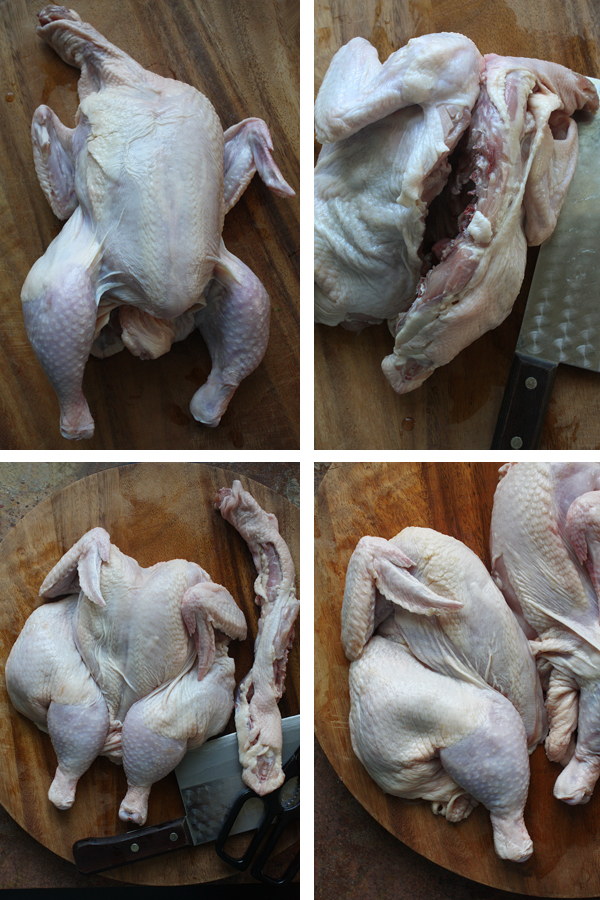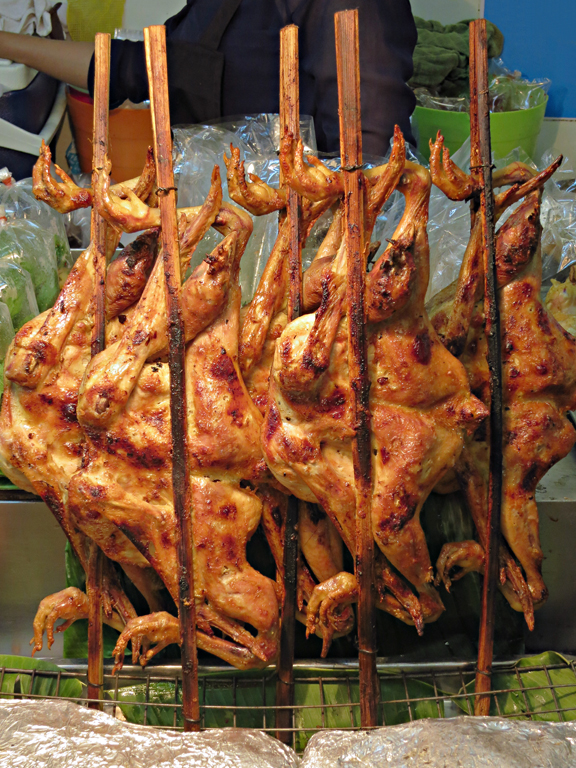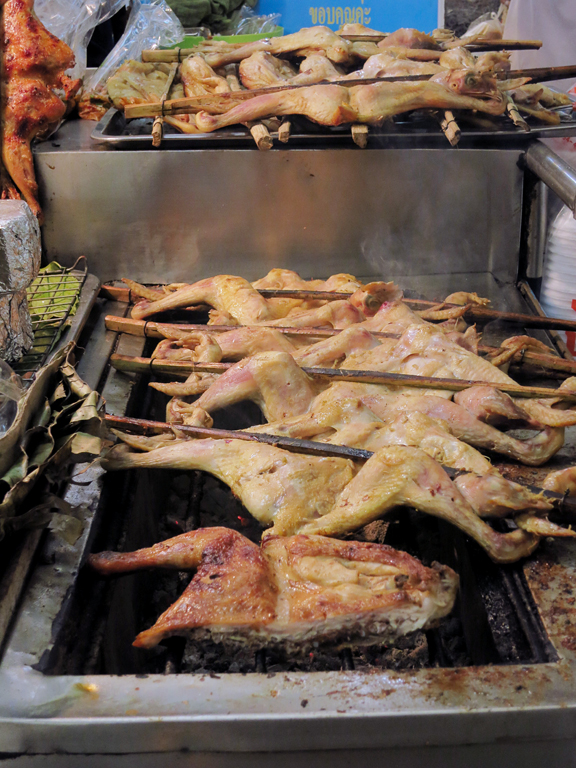It’s difficult – no, impossible – to define “traditional” Thai-style grilled chicken, because there are so many types of it. Each region does its own thing. Then we also have a handful of shops and stalls from different regions whose grilled chicken recipes became so famous that they have not only spawned franchises and knockoffs all over the place but also established some very prominent grilled chicken traditions (cult followings?). Because of this, in my opinion, we cannot categorize the various Thai grilled chicken traditions solely on the basis of geography; we must also take into consideration the businesses that have played a part in defining Thai grilled chicken in the modern days. I’ll talk more about this in subsequent pertinent posts.
But if we have to start somewhere when we talk about traditional Thai grilled chicken, I think Isan, the northeastern region of Thailand, deserves our primary attention for this is the region where the majority of Thai grilled chicken traditions were born. And although it’s not accurate to say that all famous grilled chickens in Bangkok come from Isan, Bangkokians definitely have the Isan migrants to thank for the proliferation and popularization of grilled chicken in the city.
Northeasterners take pride in their grilled chicken. This, of course, is not to say that those from other regions are sloppy with their grilled chicken. But makers of traditional Isan-style grilled chicken give so much attention and care not only to the marinade and dipping sauce, but also the type, age, and size of chicken, the type of wood used in securing the chicken, the type of coal, the type of grill, and the grilling temperature. If you ask me, I would say that northeastern-style grilled chicken traditions are the best in the country.
However, in order to appreciate Isan-style grilled chicken for what it is, one first needs to appreciate free-range chicken (kai ban, literally “home chicken”) which is by far the most popular choice of chicken for this application. The slim and lanky Thai free-range chicken is very different from its more voluptuous factory-farmed counterpart as you can see in the photo below. The criteria that you usually use to judge grilled chicken made according to non-Thai traditions, i.e. thick, meaty, and juicy flesh, cannot be applied here.

The chicken on the right is a free-range chicken made according to the tradition of the town of Khao Suan Kwang (เขาสวนกวาง) in the northeastern province of Khon Kaen (ขอนแก่น); you have to know where to go in Bangkok to get this type of grilled chicken. The chicken on the left, on the other hand, is a typical grilled farmed chicken you can get almost anywhere in Bangkok.
By the way, I know what you’re thinking right now, so let’s address the obvious. Yes, the tail end of the chicken on the left is indeed missing. Yes, I ate it. It was there, begging to be torn off and eaten, and I was hungry. And it didn’t occur to me to take the picture of the chicken until after the deed had been done. So when you look at the photo, please mentally supply a butt to the chicken on the left. Thank you kindly.

Thai-style grilled chicken is not always prepared whole; you’ll often see grilled chicken prepared in individual pieces. But from my observation, that’s usually done by random roadside cart vendors equipped with a small grill. Prominent grilled chicken shops or restaurants almost always grill their chickens whole (or at least halved or quartered), chopping them up — bones and all — only before serving or packing.
This means that if you want to grill your chicken Thai-style, knowing how to spatchcock your chicken will be of great benefit. This way, the marinade gets into the chicken thoroughly and more moisture is retained in the process of long, slow grilling (more on this below).
The photo above shows a free-range jidori chicken, weighing about 2.5 pounds (I know “jidori” doesn’t scream Thai, but it was the only smallish, free-range chicken I could find the day I prepared this post). I start by placing the chicken, breast-side down, on the chopping board (in other words, the opposite of what you see in the top-left quadrant). Then I make a cut along one side of the spine, starting from the neck all the way down to the tail end. Then I make another cut along the other side of the spine all the way to the other side of the tail end. This can be done easily with a pair of kitchen shears, but you can also use a sharp knife or a cleaver. Once that’s done, I place the chicken on the chopping board, bone-side down, and press down on the breast bone to flatten. If I want to halve my chicken, I make another cut down the center of the breasts.
The chicken is then marinated according to the recipe instructions and grilled whole over moderate to low heat. Northeastern Thai-style grilled chicken is cooked using a low temperature over a long period of time; it’s almost like you’re grilling and smoking the bird while drying out its exterior at the same time. It’s very important that you wait until you see white ash on the coals before putting the chicken on the grill. It’s best to push the coals to one side of the grill so that the chicken can be placed toward the other side where it’s cooked indirectly. Always monitor the heat and keep flare-ups from happening.
Also, I’ve found that when grilling a spatchcocked chicken, it’s best to grill the bone side first.
A 3-pound chicken should take about 30-40 minutes on the grill. If the skin burns before the 30-minute mark, the temperature is too high.
The result is grilled chicken that is thoroughly seasoned, moist on the inside, and dry-ish on the outside. You should be able to taste the marinade even in the thicker parts of the bird, such as the breasts. You should be able to detect — even taste — the smoke (I sometimes use apple wood chips to get that mild, sweet smoke, but this is neither necessary nor done in Thailand where mangrove wood coals are used). And though the meat is moist, there shouldn’t be any juices running down your hands when you pick up a piece and bite into it.
But to be honest, the best part about Thai grilled chicken is the marinade paste (which is always used regardless of the regional tradition according to which it’s made). Even if you don’t follow these grilling instructions, as long as you marinate the chicken well and don’t over- or under-cook your chicken, you’re more than okay.
The recipe for this Khoan Kaen-style grilled chicken mentioned here will be part of the ongoing Thai Grilled Chicken: The Heroine Upstaged by Her Sidekick series. Please stay tuned.










10 Responses to Thai Grilled Chicken: The Basics